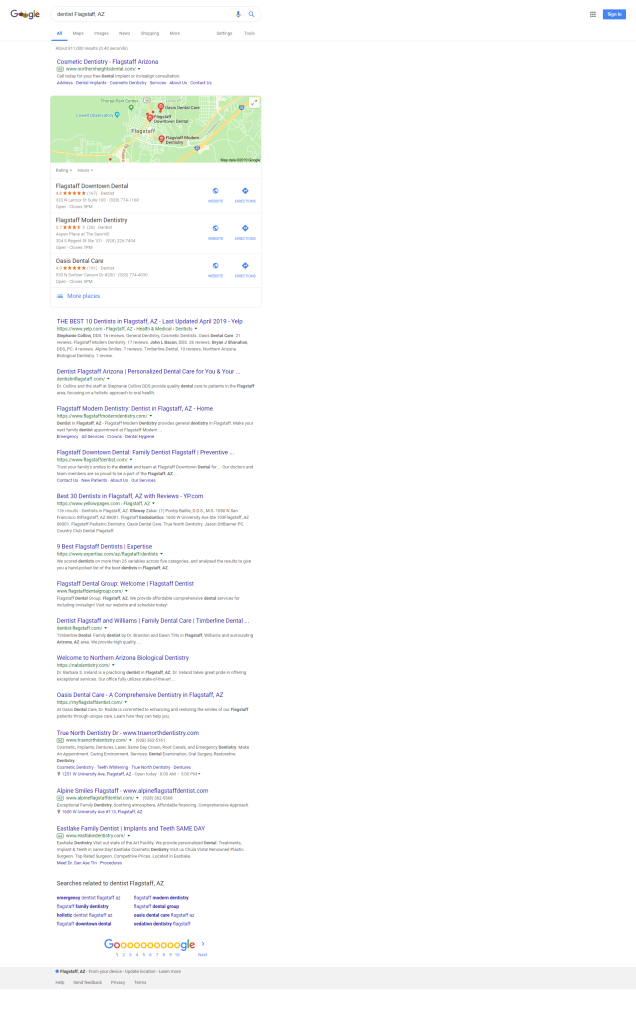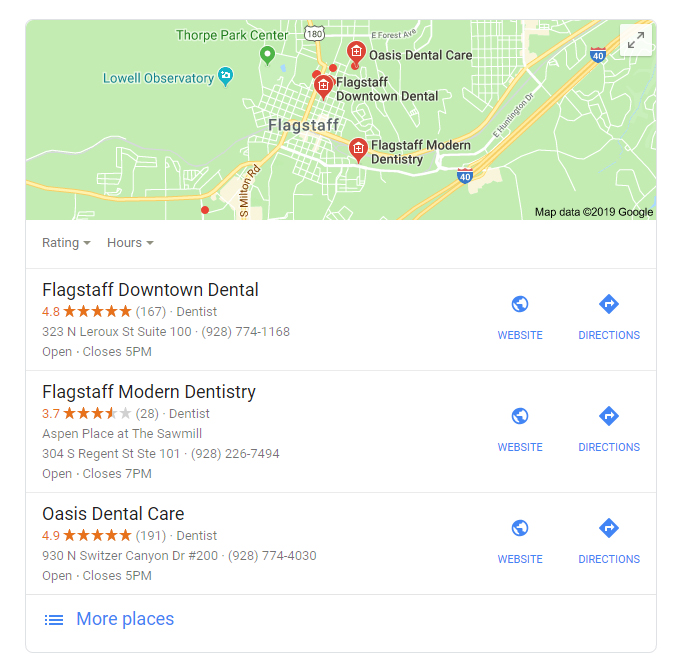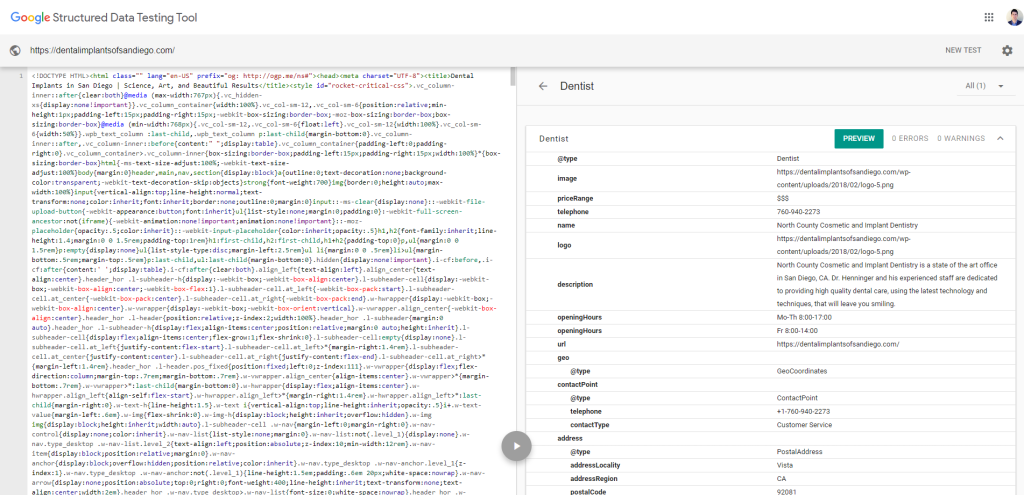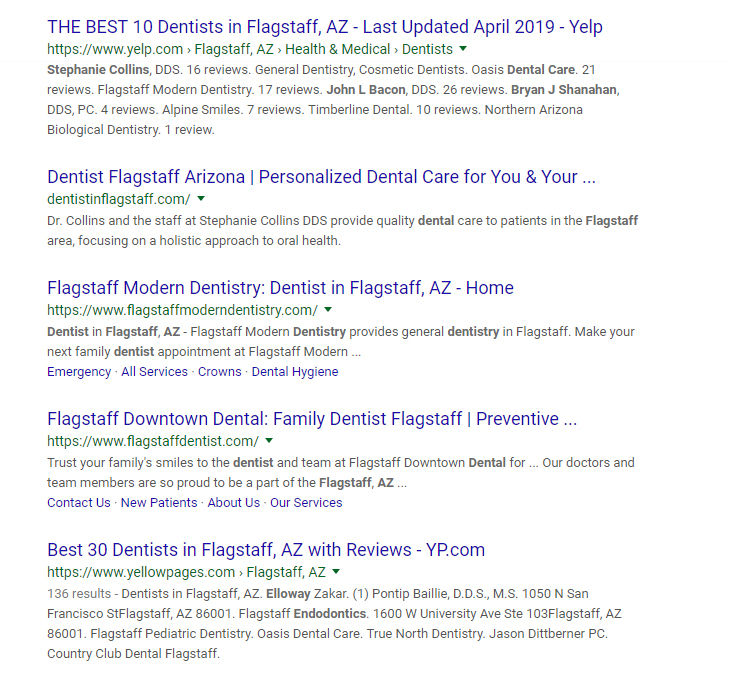Is SEO a black hole for small businesses?
To the many who spend a lot of money month after month, it sure feels that way, especially if you’re not quite sure where that money is being spent.
It shouldn’t be that way. In a world where Google is completely intertwined with our lives (and your customers’ too), SEO is absolutely crucial for any business.
This guide is meant to give busy small business owners a better idea of what the elements of small business SEO are and how to think about them strategically to generate more revenue.
What’s covered:
- The Ins-and-Outs of Local SEO
- All You Need to Know About Organic SEO
- The World of Deep Search
- How to Rank on Yelp
- How to Measure ROI From SEO
What a Typical Search Engine Results Page (SERP) Looks Like
Below is a screenshot of what a typical Google results page looks like for a local business search, in this case for a dentist.
Each element on the page serves a distinct purpose that we’ll delve into individually. I just want you to see it all together so we can start to form a picture of how these elements build and interact with one another.

We’ll come back to the big picture toward the end.
The Ins-and-Outs of Local SEO
All small business results are local these days, but ‘local SEO’ typically refers specifically to the map pack:

Ranking in the map pack matters because:
- It’s prominent, visual, and above the traditional organic listings.
- Restricted to three or four listings, it allows your business to stand out against the competition.
- The listings are built to drive immediate action.
Good placement on the map results directly drives revenue to your store.
Great, so how do you rank on the map pack?
Grabbing a Top 3 Map Pack Listing
Local SEO is multifaceted and the biggest factor may not be in your control. That factor is distance. The closer you are to the person making the search, the more likely you are to show up in that map pack for them.
Of course, there are other factors which are in your control:
Google My Business (GMB) — Google My Business is alive and absolutely necessary for anybody looking to rank in the map pack. In fact, it has become more and more important over the years.
GMB optimization is relatively simple. Keywords, especially exact match keywords, are a strong signal. In some cases, Google is rewarding exact match keywords over factors like reviews, backlinks, and even having a website at all. If your business name is well-optimized, like “San Diego Dentistry,” then that’s very good news, but you can also use keywords in the business bio and posts.
Uploading new photos, acquiring new reviews, frequently adding posts, and answering Q&As are all part of optimizing GMB, as well. Beyond ranking, the more you optimize, the higher the chance of a customer reaching out to you. Elements like photos and posts help differentiate your business from others.
Reviews — Like Google My Business, reviews have risen in importance over the years too. Reviews are great news for both your local SEO and your ability to convert search traffic into customers, and they’re even better when they have some degree of keyword optimization. You can help increase keyword optimization by asking customers to mention specific services or products in their review.
How do you get more reviews? Ask. Ask every customer.
Set up marketing automation to send out emails, Facebook Messenger messages, and texts asking for reviews. Ask your customers when they’re in the building or after they just purchased something.
Be proactive and seek reviews. Businesses that wait for them don’t get enough, and when they do, it’s not the sort of review they were hoping for.
Backlinks — We’ll be talking about links again below, but they’re one of the most important local SEO ranking factors. According to Moz’ 2018 industry survey, backlinks are even more important than reviews and citations, which we’ll talk about next.
Despite their importance, link-building strategies are rare among small businesses. In fact, according to Moz’ 2019 local SEO industry report, 35% of marketers have no link-building strategies at all.
Oftentimes, the best sources for links are the other business owners in your area. They have websites and need links to, and there are always plenty of organic and sensible ways that different products and services can complement one another. Leverage your local network to build links.
Sponsorships and community events are also excellent opportunities to earn backlinks and “unlinked mentions.” An unlinked mention is when your business name is mentioned but not directly linked. These have a lot of value too because they help solidify your online brand reputation, as mentioned by Nabeena Mali in her small business marketing strategies guide.
Which nearby businesses have a blog? Are there any nearby events you could sponsor? Do you publish on your specialty? Publishing on third party websites is another fantastic method of earning new backlinks.
Citations — Citations are, essentially, online business listings. Google My Business is one of them and there are hundreds of others. Your business is listed on many of these, whether you know it or not. They take the data from other sources, such as Google and Yelp.
Making sure all of your business citations are consistent with the information on your website is important because it ensures that your website is getting credit for your brand’s online presence. Inconsistencies make it more difficult for Google to give credit where credit’s due, leading to untapped ranking potential.
Whereas Google My Business and reviews have grown in importance, citations have declined in their relative role. This is partly because of new ranking factors, but also because as more and more businesses standardize their citations across the web, it’s becoming less of a distinguishing characteristic.
Business Schema — Business schema, a back-end code, basically makes the fundamental facts about your business explicit, including name, location, phone number, and hours of operation. This is basic schema and all small business websites should have it set up.
If you’re looking for an easy way to add it, I recommend the plugin WP SEO Structured Data Schema.
You can test whether the schema on your website is correct by using Google’s testing tool.

On-Page SEO for Local SEO — We’re going to talk more about on-page SEO below, but I mention it here because it’s relevant to ranking in the map pack. Optimizing your H1s and content by making them relevant and attractive to searchers is fundamental.
All You Need to Know About Organic SEO

Directly below the map pack is where you’ll find the traditional organic listings. Ranking here is still important, but with so much real estate taken up by other features on the SERP — ads, map pack, ads, and answer box — it’s as important as ever to rank toward the top.
You’ll notice from the above example that the first spot is occupied by Yelp, a trend that’s mirrored in 95 to 100% of other local business searches. The fifth is taken up by Yellowpages. Oftentimes, you’ll see Groupon as number two. This fact is important and we’ll come back to it below, in the section on deep search.
There are perhaps over 200 ranking factors that determine how well your site performs organically. Let’s go over the major ones.
Great, Engaging Content — Have you ever talked to someone, didn’t feel their energy, and simply couldn’t keep up with the conversation because it wasn’t interesting to you?
This happens with content too.
Your readers are coming to your website with a specific intent driven by specific needs. Is your content speaking to these needs? Is it validating the emotions that drove the reader to your website? Or does your content fall emotionally flat?
There’s a focus on “delivering value,” which is a good focus to have. But, have you noticed how the same statement delivered two different ways can be interpreted in two different ways? The way that information is delivered matters and if your content isn’t delivering value in the right way, then it’ll inevitably fall flat.
Backlinks — After Google started to penalize some websites for spammy backlink strategies, a lot of SEOs began to switch focus to “great content that earns organic backlinks.” Yet, teams that don’t have promotion strategies find that their content, no matter how great it is, simply isn’t being seen. The people who would backlink to it don’t know it exists!
Proactive backlink strategies are still a must for SEO.
The best links are from local and/or relevant websites. That’s why it’s such a good idea to leverage your local business connections for backlink and cross-promotion opportunities. For similar reasons, if you publish or write for third-party periodicals on topics related to your business, these are also fantastic sources of links that should be actively pursued.
Do you have vendors whose products make an impact on your business? See if they’d be willing to write a case study on how your business uses their product. Provide them with relevant information: an interview, photos, whatever they need. Case studies are a great source of backlinks and the vendor wins an endorsement.
Mobile-First Design — What’s the difference between mobile-first and responsive? Philosophy.
The majority of traffic is mobile now. A mobile-first design approaches building a website with the focus on optimizing the experience for mobile versus making mobile an afterthought (or simply a “responsive” version of the desktop version).
Why is this important? Because if content and user engagement matters, it’s fundamental to think about how the content is consumed and how the user is engaging. Right now, that means thinking in terms of mobile phones.
Page Speed — Priority on speed has a lot to do with mobile. Page speed is important across devices, but we live in a world where experiences are fleeting and we’re swiping our phone screens every few seconds. People expect to receive what they’re looking for quickly and they won’t wait around for the site to load.
Page speed is a direct ranking factor. It also affects your conversion rates. A one second increase in load speed can drop conversion rates by 50%+.
Strong, Attractive Listing Copy — The technical terms for listing copy are title tags and meta descriptions. On Google, they look like this:

Listing copy matters because it has to persuade a searcher that this website out of all others is the one worth clicking on.
If you take a look at the screenshot of the entire SERP, that page is full of different options. Your listing copy, the title tag and the meta description, is the principle method you have to influence the searcher.
You can enhance your listings by including schema, which is a type of back-end code, to provide Google with reviews and information on the author or business owner, among other things. Whether Google will take what the schema provides it is up to Google, and oftentimes Google doesn’t need schema at all, but it doesn’t hurt to optimize your website as much as you can.
Title tags and meta descriptions don’t directly impact rankings, so don’t worry about keyword stuffing them.* How users interact with them is what truly matters. What that means is if people aren’t clicking on your listing, if they don’t find it compelling, then Google is likely to see that and eventually put someone whose listing is performing better in your spot.
* One exception is the title tag. Moz has found correlation between front-loading the keyword in the title tag and better rankings.
On-page optimization — On-page optimization and content are related, but I like to separate the technical SEO elements from the fundamental necessity of strong, engaging content.
Keyword density and metrics like that don’t matter as much anymore because (a) Google is getting better at understanding what web pages are about and (b) Google is getting better at eliminating loopholes in the SEO game.
Nevertheless, keywords still matter. Every web page should have one and only one H1. That is the main heading, the headline, and it should include the main keyword you’re targeting.
Content length and comprehensiveness matter, as well. I talk about it here versus in the section on quality content because thinking about content comprehensiveness is actually a great way of thinking about keywords. For example, why split up an Invisalign page into “What is Invisalign” and “Am I an Invisalign Candidate?” pages when you can have one page that talks about everything?
From the user’s perspective, this reduces the amount of hoops they have to jump through to find the information they need.
For the business, data shows that Google rewards content length and comprehensiveness. Redundant, boring, and over-elaborate content is no good. Talking about your subject in a way that addresses all pain points, concerns, and interests is great.
Website structure — Google can better understand how different pieces of content on your website relate to each other when these pieces are organized in a way that makes their relationship explicit. Traditionally, this is done by organizing content around link structures.
What does that mean?
Let’s say you’re a dentist. Of the following two website structures, which one do you think is more clearly organized?
Version A:
- /cosmetic-dentistry/
- /dental-implants/
- /full-arch-restorations/
- /general-dentistry/
- /invisalign/
- /post-operative-instructions/
- /supplemental-procedures/
Version B:
- /cosmetic-dentistry/
- /cosmetic-dentistry/invisalign/
- /dental-implants/
- /dental-implants/full-arch-restorations/
- /dental-implants/post-operative-instructions/
- /dental-implants/supplemental-procedures/
- /general-dentistry/
Version B does a better job of making it explicit how all of those pages are related to each other, doesn’t it?
By making the topical relationship between pages more explicit, the individual pieces of content can better support each other. The whole, after all, is more than just the sum of its parts.
Content freshness — How often content is re-written or expanded can indirectly impact how well your website performs on Google.
How often content is updated may not directly influence rankings. However, focusing on building up existing content helps avoid keyword cannibalization that comes with content over-production and it gives the opportunity to fine-tune existing content by making it more comprehensive and better written.
In other words, if your content isn’t ranking, don’t produce additional content that’s simply competing for the same key terms. Instead, improve the existing content’s ability to rank.
Site security — All websites should have HTTPS.
The World of Deep Search
We know that for major cities, Yelp occupies the top spot for a local business search almost 100% of the time. For small towns, it’s 90–95%. Along with Yelp, there are sites like Yellowpages and Groupon that also tend to dominate search because of their sheer authority.
Those listings, just by virtue of their brands, what they offer (a list of top rated businesses), and their positioning are going to get a lot of clicks. Worse still for the small business, they are very difficult to dislodge.
Deep search is a fancy buzzword for thinking strategically.
If someone clicks on the link to Yelp, they are going from the Google SERP to a Yelp SERP and if you want any chance of getting their business, you also want to be on that Yelp SERP.
Many small business owners, especially dentists, opt to ignore Yelp altogether. For a lot of businesses, it’s hard to get good reviews, it’s hard to challenge unfair reviews, and the whole experience leaves a bad taste. The fact is, Yelp and sites like it have market power (especially in the realm of voice search). They’re here to stay, and as a business owner looking to earn more revenue and grow, you’ll need to grapple with their like sooner or later.
How to Rank on Yelp
Like Google, Yelp’s algorithm isn’t public. There are, nevertheless, several factors that are known and worth mentioning:
- The number of reviews.
- The average rating.
- The credibility of the reviewers.
- The relevance of the keywords used in the reviews.
- Engagement with the Yelp listing.
Yelp is very keyword-driven, more so than Google in some respects.
When asking customers to review your business on Yelp, ask them to explicitly mention the services or products they enjoyed. That’s an easy, organic way of asking them to include certain keywords.
If you’re having trouble generating reviews, I recommend looking into reputation management automation. Requesting reviews from customers should be done at scale.
Finally, flesh out your listing. Add photos, make sure the categories are up to date and complete, and dial-in your call-to-actions. And respond to the reviews you get, whether good or bad.
More Yelp Pro-Tips:
- Ask customers to check-in before leaving a review. This will decrease the chance that their review is filtered because of inactivity.
- Asking customers to check-in also sets off an automated task for Yelp to remind the customer to leave a review later.
- Review freshness impacts your ranking on Yelp. Your reputation management campaign should be ongoing.
How to Measure ROI From SEO: The Metrics That Matter
SEO is expensive and the results don’t tend to be obvious. Businesses without anyway of tracking progress or success can get frustrated because they have no idea whether their investment in SEO is paying off.
Revenue — The best way to measure ROI from anything is to track how much revenue is being earned for each dollar spent.
With Google Analytics, that’s easier than ever. For example, through Google Analytics, you can track when someone fills out your contact form or buys from your online store. Furthermore, Google Analytics knows when someone reached your website through an organic search and they’re able to connect that form they fill out with the traffic source.
Tracking phone calls is more difficult, but you can use a special tracking number through a method called dynamic number insertion (DNI) that only shows up when someone clicks on your website from a SERP. Most call tracking software integrates with Google Analytics, though not always well enough to allow Google Analytics to connect the call with the traffic source. But if you’re using a specific number only available to customers who found you through search, you can manually compare phone calls with your monthly SEO spend.
Changes in Organic Traffic — Ranking is great, but what if you rank for a bunch of keyterms that don’t bring traffic?
Better than positioning, organic traffic volume data can help you gauge the success of your SEO program. Again, the ultimate goal of positioning is to earn traffic, so what better metric than traffic is there to grade performance?
Backlink Profile — If link-building is crucial to SEO success, whether for local or traditional SEO, how is your backlink profile changing over time? Is your SEO team improving that profile? Is it staying the same? Shrinking?
Furthermore, are those backlinks high quality? Are they increasing your domain authority?
Tracking your backlink profile and the overall authority of your website is a fantastic proxy for gauging the success and quality of your SEO. There are a number of tools that make this easy, including Ahrefs and SEMrush. Ahrefs, for example, has an aggregate metric called URL Rating (UR) that weighs the strength of the site’s backlink profile.
The Big Picture
Like I said in the beginning, there are a lot of individual pieces to SEO, but the overall value can only be understood if you’re looking at the big picture.
SEO is more strategic than ever. Google is giving users more choice and it’s organizing the results in ways that bring prominence to some listings over others. Furthermore, big, popular directory websites like Yelp are consistently outranking small businesses in small business searches, so it’s becoming necessary to play on their field rather than trying to compete with them.
As we’ve seen, a lot of the individual pieces interact with each other. Backlinks not only help traditional SEO, they also improve rankings on the local map pack. Similarly, traditional SEO can help raise your positioning for revenue-driving keyterms, but you won’t necessarily be able to outperform Yelp or Yellowpages, requiring an SEO strategy that looks at both traditional SEO and reputation management.
The whole is greater than the sum of its parts. Successful SEO builds the individual pieces, but always to fit them into a larger puzzle.
